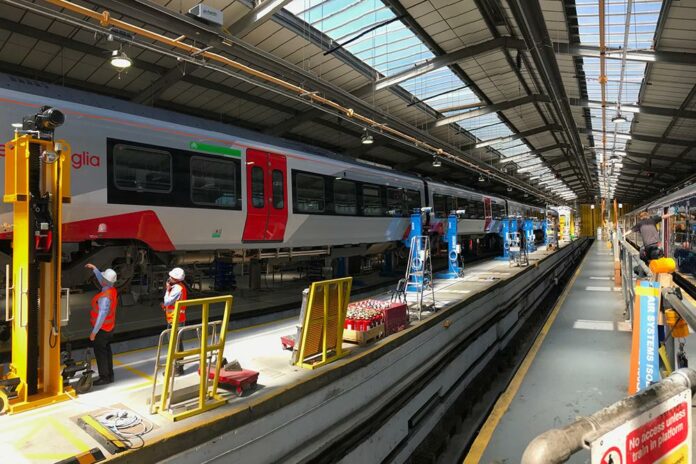A new train lifting facility has been installed at Greater Anglia’s Clacton rail depot to accommodate the operator’s fleet of Stadler bi-mode trains – even though lockdown almost threw the project into jeopardy.
The work to install four additional lifting jacks to work alongside the existing 16 has seen the entire train lifting facility redeveloped, the biggest project undertaken at the depot in years.
This means that the depot can now lift the new trains – which operate on Greater Anglia’s regional routes in Norfolk, Suffolk and Cambridgeshire – in order to get underneath them, for example to repair or change the wheels.
Additional jacks were needed to increase the maximum weight that the train lift could accommodate – as the new Stadler bi-mode trains are heavier than Greater Anglia’s old trains.
The project saw four 18-tonne Mechan jacks installed alongside the existing 16 Sefac 15-tonne jacks. This involved a complete rewiring of the system and a new control network from SEFAC to ensure all the jacks communicated properly with each other so that the lift would operate smoothly and safely.
The addition of four higher capacity Mechan jacks and the increased length of the new train meant the entire floor – the length of four train carriages – had to be dug up, levelled and strengthened to meet tolerance requirements.
Some of the equipment came from France, which went into lockdown earlier than the UK and it looked like the project would grind to a halt.
Greater Anglia entered into negotiations with the manufacturer and French civil servants, and fortunately were able to find a solution which saw the vital machinery fitted in the depot.
Depot engineers tested the new lift on 18 June 2020, successfully lifting a four-carriage Stadler train.
Greater Anglia’s Head of Program Safety & Assurance, Steve Clarke, said: “Working together with Sefac, Mechan and our colleagues at Clacton Depot we’ve created a very satisfactory solution to the problem of how to safely lift the new train fleet.
“The depot is now ready to accommodate the new bi-mode trains and play its part in ensuring that they continue to perform well, to improve reliability and punctuality for passengers in the region.”
SEFAC UK director, Vincent Jolliot, said: “When we were first approached at the end of last year by Greater Anglia to upgrade the existing set of 16 15-tonne jacks into a set of 20 in a very short period of time, we were pleased to accept the challenge to integrate four jacks from Mechan with different lifting capacity to be operated in full synchronization and in accordance with the latest norms and regulations.
“We immediately thought that our latest developed control system ISOP5-MULTI would be flexible enough for this purpose as it offers the possibility to operate different configuration adapted to different STADLER trains with an additional constraint: always have the pairs of 18-tonne jacks at both extremities of train whatever the type of train and still lift the Class 321 trains fleet.”
He also added that ‘without the great support from Greater Anglia to organise the final test on site during lockdown and the full commitment of the SEFAC French team, the success of the project would not have been so complete’.
Mechan’s Engineering Director, Martin Berry, said: “We were pleased to be able to provide Greater Anglia’s Clacton facility with four of our flagship lifting jacks to help ensure the facility is properly equipped to lift the new Stadler trains. The railway is constantly developing, and it is great to be a part of the futureproofing of facilities.
“For this project we had to modify our design to be able to work alongside the Sefac jacks. The motor and gearbox were modified to match the lifting speed of the current jacks, as well as a castor wheelbase arrangement to allow the movement of the jacks around the depot. Working alongside Sefac to enable both sets of jacks to lift together has been a successful collaboration.”
Clacton rail depot re-opened 10 years ago after a period of closure. It now employs 16 engineers as well as a production engineer, storeman and depot manager.
Their main focus is maintaining Greater Anglia’s fleet of Class 321 trains which operate in Essex and thanks to their hard work, this fleet is currently recording its best performance figures for four years.
Photo credit: Greater Anglia
For today’s rail news from railbusinessdaily.com click here.







































 0113 2082620
0113 2082620 info@railbusinessdaily.com
info@railbusinessdaily.com 15 Mariner Court, Wakefield WF4 3FL
15 Mariner Court, Wakefield WF4 3FL

